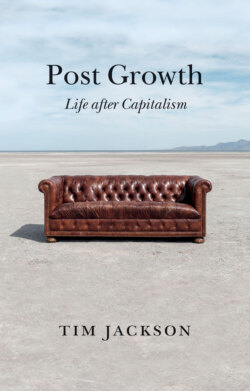Читать книгу Post Growth - Tim Jackson - Страница 19
Is growth an illusion?
ОглавлениеIt had been a bad year (indeed a difficult decade) for Deutsche Bank. Rocked by controversy over its financial dealings with the Trump empire and still recovering from litigation settlements which dated from before the financial crisis, it had posted two consecutive quarters of substantial losses immediately prior to Davos. Its $1.4 trillion assets still placed it as the seventeenth largest bank in the world in 2020. But those assets had fallen dramatically from a pre-crisis peak of $3.6 trillion. Growth was almost literally an illusion for the ailing giant.6
It has been increasingly elusive for the advanced economies as a whole. The 5% growth rates typical of the US economy in 1968 are now long gone. By the start of 2020, even before the pandemic, the average rate of growth across the OECD nations was barely 2%. If we measure the average growth rate per person over these periods – a better indicator of what economists call living standards – the decline is even more obvious. And if we measure ‘labour productivity’ – the average output generated per hour worked in the economy – then things look worse again.7
In the UK, the oldest of the developed economies, the picture is particularly striking. From a peak of around 4% in 1968, the trend growth in labour productivity had already fallen to less than 1% before the financial crisis in 2008. In the aftermath, its descent continued. In the years before the coronavirus crisis, there was virtually no growth in labour productivity at all. Sometimes – most strikingly through the pandemic – productivity growth went into reverse. Labour productivity declined in absolute terms across the economy as a whole.8
These trends matter. It’s only possible to squeeze GDP growth out of an economy with stationary or declining labour productivity by increasing the hours spent working there. Either more people must work or else each of them must work longer hours. Neither of these things is consistent with the promise that capitalism held out to us. Once labour productivity growth goes into reverse, in fact, we are already to all intents and purposes living in a postgrowth world. Figuring out how to survive – let alone flourish – under these circumstances is no longer trivial.
For the most part, economists don’t try. They either deny the reality of these trends or else they assume we can somehow turn the ship around and return to the good old days. A sense of anxiety pervades this denial. Davos was full of it. ‘Deep new rifts are tearing apart the fabric of our societies,’ warned the development economist Paul Collier, because ‘Capitalism’s core credential of steadily rising living standards for all has been tarnished.’ The very next day, it was the turn of billionaire Marc Benioff, Chair and co-CEO of Salesforce. ‘Capitalism as we have known it is dead,’ he lamented.9
The air of bemusement was palpable. Not that long ago, things were going so well. Living standards were rising; democracy was thriving; freedom – the buzzword of western liberalism – abounded. And with the fall of the Iron Curtain, political opposition to the dominant economic model seemed to have faded away. Capitalism could deliver all the progress we ever needed. The political scientist Francis Fukuyama was even persuaded to declare that we’ve reached ‘the end of history’: the pinnacle of humanity’s ideological evolution.10
A representative state; a market economy; a consumer society: this was the recipe for social progress. Governments across the world were content to follow its rubric. And yet the formula had evidently failed. So what exactly happened? How did it all go so wrong? Who killed capitalism?
